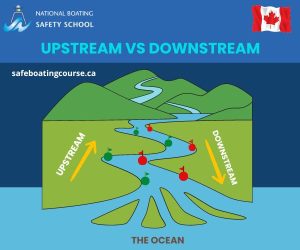
Upstream vs. Downstream: Boating Info
It’s important to know the difference between upstream and downstream so you can correctly interpret buoys and avoid collisions.
Upstream vs downstream
What’s the difference between upstream and downstream, and how can you tell once you’re out on a river?
The most reliable method is consulting a marine chart for current information. Always take up-to-date marine charts with you when boating!
These definitions and clues could also help you figure it out:
Upstream
When you are going upstream, you are moving towards the source of the water, typically inland from the sea.
How can you tell?
- When going upstream, you’re moving against the current. If your boat feels like it’s fighting the natural flow, you’re likely going upstream.
- If entering a waterway from the sea, you’re going upstream.
- Water often flows north to south, so if you’re heading north, you’re likely traveling upstream.
Downstream
When you are going downstream, you are moving away from the source of the water, typically towards the sea.
How can you tell?
- When going downstream, you’re moving in the same direction as the current. If your boat is moving without any source of mechanical or human propulsion, you’re likely going downstream.
- If moving along a waterway toward the sea, you’re going downstream.
- Water often flows north to south, so if you’re heading south, you’re likely traveling downstream.
Interpreting lateral buoys
Boaters need to know the difference between upstream and downstream to follow buoys and stay on the right side of the channel. Learn more about navigating narrow channels in our article!
There are two types of buoys that indicate which way to go when heading upstream:
Port hand
Port hand buoys are green. They should be on your port (left) side when heading upstream.
Starboard hand
Starboard-hand buoys are red. Keep red lateral buoys on your starboard (right) side when heading upstream.
Get your boating licence from Canada’s National Boating Safety School!
Before heading out on the water, it’s important to learn about Canadian boating rules and regulations. These laws have been put in place to keep passengers and captains safe, and cover everything from when to wear a PFD to installing boat radar reflectors.
Take a safe boating exam online and get your Canadian boating licence today!


